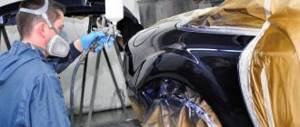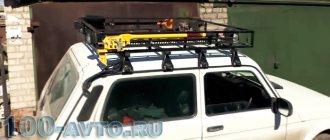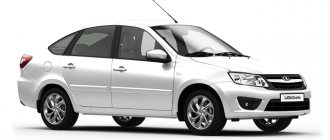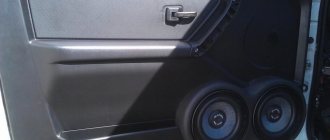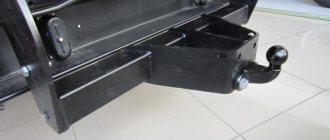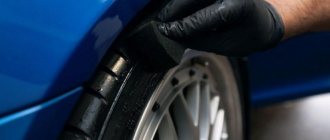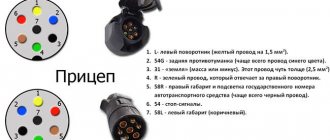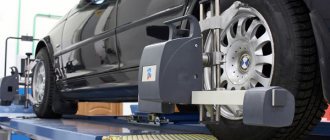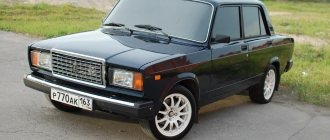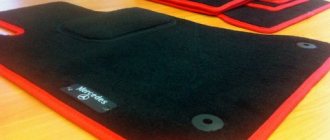Types of fenders
Wheel arch extensions are presented on the modern market in several variations:
- universal. These are rubber pads sold in rolls. The use of such parts has no restrictions on the make or model of the vehicle - when installed, they can easily be adjusted to any arches. But despite the excellent protective properties, universal arch extensions do not have an elegant design and significantly worsen the appearance of the car, which is why they are most often purchased by SUV owners;
- plastic. They are attractive, but are produced for a specific model. Fixation to the body is carried out using self-tapping screws. A significant disadvantage of plastic wheel arch extensions is the low level of protection and fragility, so they are most often used for beauty;
- fiberglass. The pads are quite durable and look like plastic ones. Most often they are made by hand or made to order;
- fiberglass. They are characterized by excellent appearance, as well as good protective qualities. They are quite expensive. In addition, the installation of these elements is a labor-intensive and complex process. To install such a wheel arch extension, you must first clean its surface and apply a layer of putty. After this, the trim is aligned with the car body, secured with self-tapping screws and painted with the appropriate shade of paint.
Wheel arch extensions are presented on the modern market in several variations
DIY wheel arch extensions
Today it is very popular to install wide-profile tires on car wheels. This type of tuning has become widespread among car enthusiasts. This is explained by the fact that in this way the adhesion of rubber to the road surface improves, and thus the driving performance of the car improves.
However, this type of tuning leads to the fact that in some cases, when the rim width is increased very much, it is necessary to widen the car's wheel arches.
Do-it-yourself fenders for arches
If we talk about the goal that we pursue when widening the wheel arches of a car, we can name 2 main factors:
- protection of the body from dirt, dust and stones flying from under the wheels;
- improving the appearance of the car.
For this purpose, you can purchase universal fenders or make arch extensions yourself.
Ready-made fenders
On sale you can find ready-made overlays that allow you to widen the wheel arches of your car. You can find the following options in stores:
- Universal rubber pads. Sold in rolls. They are usually used by owners of off-road vehicles. However, rubber pads do nothing to improve the external aesthetics of the car - they only serve to protect against dirt and stones. Therefore, they are not very popular among car owners.
- Fenders made of plastic. They are attached to the arches using self-tapping screws.
- Fiberglass body kits are covers that are mounted on arches with self-tapping screws. The surface and gaps are covered with putty, after which they are painted to match the main color of the car.
If such overlays turn out to be unsuitable for some reason, you can make arch extensions with your own hands.
Car wheel arch extensions
We expand the wheel arches of a car using polystyrene foam
Expanded polystyrene is great for widening the wheel arches of your car. It has the following advantages:
- affordable price;
- non-hygroscopic;
- low specific gravity;
- excellent machinability;
- high compression resistance;
- non-flammability.
The process of working with polystyrene foam in our case is as follows:
- Using Macroflex we glue the foam pieces to the car body.
- Using a knife and sandpaper, we give the material the desired shape.
- We apply resin to the treated polystyrene foam.
- We overlap the fiberglass, making sure that there are no air bubbles.
- We wait for the fiberglass to dry and perform puttying.
- We grind the dried putty, fill all the irregularities with filler and wait for it to dry.
- We sand again and treat with a primer.
- After the primer has dried, we paint the arches to match the color of the rest of the car.
DIY wheel arch covers
Using sculptural plasticine
If you were good with plasticine in school, you can use this skill to fashion extensions for your car from it. The algorithm consists of the following stages:
- Contact areas of the body are covered with construction tape.
- Sculptural plasticine is glued to adhesive tape, and overlays are formed from it. This is quite painstaking work - you need to ensure the correct shape and symmetry.
- Once you are satisfied that the shape suits you and both sides look symmetrical, you can coat the resulting pieces with epoxy resin and fiberglass. At least 3 layers should be applied.
- After drying, remove the plasticine from the mold.
- Fix the resulting products with self-tapping screws on the body of your car.
- Next - perform puttying, priming and painting, as described in the previous section.
DIY wheel arches
Application of polyurethane foam
Another suitable material for forming wheel arch extensions is polyurethane foam. Working with it is quite simple, and the algorithm looks like this:
- We use standard plastic fenders as a basis - we divide them into parts and fix them with self-tapping screws on the car body.
- First, from below, and then from above, we blow out layers of polyurethane foam.
- We wait until it dries, after which we give it the desired shape using sandpaper and a knife.
- For strength, we coat the resulting fenders with epoxy and fiberglass, as described above.
- Next we putty, sand, prime and paint as indicated in the previous sections.
Conclusion
It is important to understand that widening the wheel arches should be done when wide-profile tires are installed on the car. In this case, we will need effective protection of the body from stones, dirt and other negative factors.
You can purchase ready-made fenders and install them on your car, or call on all your creative abilities and make the fenders yourself. For this purpose, materials that have good machinability and allow you to obtain the necessary strength and durability are suitable.
During the work process, it is important to monitor the shape and symmetry - the result should not only protect the body, but also look beautiful. Be careful, take your time, use all your creative abilities - and the result will definitely be beyond praise.
[democracy]
[democracy]
Author: Baranov Vitaly Petrovich
Education: secondary specialized. Specialty: car mechanic. Professional diagnostics, repair, maintenance of passenger cars of foreign production 2000-2015. Extensive experience working with Japanese and German cars.
okuzove.ru
Popular manufacturers
Today, many domestic and foreign companies are engaged in the production of extenders for car wheel arches. The following have proven themselves to be the best:
- Bushwacker is an American company with many years of experience, producing a variety of accessories for various models of SUVs and pickups. The production uses high-quality materials that are resistant to ultraviolet radiation, low temperatures, and also resist the destructive effects of acids and salts found in dirt or natural waters.
- GFG is a Spanish company known not only for its accessories for vehicles, but also for the production of special additives that make the car more economical and the fuel materials used by the car owner more environmentally friendly.
- Cezar is a Polish company that produces high-strength plastic tape materials.
- Master Sport and Russian Artel are Russian companies that are equally successful in manufacturing wheel arch extensions for domestically produced cars - Zhiguli, UAZ, Lada Niva.
Bushwacker Wheel Arch Extension
Wheel arches, what they are
01.11.2017 | 2091 views
These car body elements, in addition to being aesthetic, also have protective functions. Moreover, the wheel arch, to a large extent, provides the necessary rigidity of the body.
The first cars that appeared a little over a hundred years ago were most similar to carriages and carriages, and this is not surprising, since their design was worked out by the same carriage makers; they simply did not have other examples.
Gradually, over time, technologies changed, technical characteristics improved, speed increased, new design solutions and layout methods appeared. One striking example of such design changes is the gradual change in the position of the wheels. In the first car models, they were always located behind the body line and were not covered with anything. Later they began to be covered with wings. In the 30-40s of the last century, we can say that an automobile revolution took place, models began to be created in which the wheels no longer extended beyond the body, then the concept of “wheel arch” appeared. Essentially, this is a niche of a semicircular shape or close to it, located in the body of a car , it houses the wheel.
What problems does this body part solve:
- Provides movement of the wheel in the plane in the vertical range of travel of the suspension parts.
- The front wheel arch, both left and right, provides the maximum possible wheel rotation angle.
- Protects internal body elements from dirt and damage from objects falling from under the wheels while driving.
- Maintains the necessary body rigidity.
- Acts as an important design element that gives the car aesthetics.
Types and design of wheel arches
The wheel arch itself is just one of the parts in the body niche in which the wheel is installed, but according to tradition, other parts are sometimes called an arch or its component elements, so all wheel arches are divided into two large types, they are solid and composite.
— A solid arch is a single element that is installed in a body niche, bolted to its lower and side parts, as well as to the wings.
By the way, in many cars these parts, especially the front arches, are called mud flaps, but their essence and purpose do not change from this name.
— A composite arch is divided into internal and external parts. The first is the arch itself, welded to the body by spot welding, the second is the outer one, most often made of plastic, carries aesthetic functions, they are usually attached to the body with screws or latches.
The latter type of wheel arches is the most widespread today. The fact is that such a body part is constantly exposed to dirt, sand, dust and water falling from under the wheels. Such intense influence leads to body corrosion. As a result, problems arise that require complex solutions and large investments, but plastic parts are not subject to corrosion, moreover, if damaged, they can be easily replaced with new ones, and experienced car enthusiasts do not even have to contact a service center for this.
The outer, plastic part of the arch can also be damaged when the wheel hits an object or stone.
This part often becomes unusable when driving on bad roads or even rough terrain. For owners of such a popular Kia Rio 3 model today, replacing the plastic part of the arch will not be difficult; with skillful use of a screwdriver and a wrench, you can do it yourself, and if only the front right wheel arch needs repair, you can get by with minimal investment. Share:
